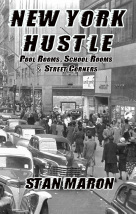 Stan Maron’s New York Hustle is a moving and intense memoir, a look back that begins in the 1940s. As a working-class Jewish kid growing up on the New Jersey shore, Maron lived in a violent, dysfunctional household. Life in his family’s Asbury Park home was tumultuous, with little money and frequent spats. But the central issue of the book is a mystery that has haunted him for more than seventy years: When Maron was nine, in 1943, his healthy, 42-year-old mother died. Suspicion that his father had strangled her — something many of the family elders assumed — tarnished Maron’s coming-of-age and left him terrified, confused, and sad.
Stan Maron’s New York Hustle is a moving and intense memoir, a look back that begins in the 1940s. As a working-class Jewish kid growing up on the New Jersey shore, Maron lived in a violent, dysfunctional household. Life in his family’s Asbury Park home was tumultuous, with little money and frequent spats. But the central issue of the book is a mystery that has haunted him for more than seventy years: When Maron was nine, in 1943, his healthy, 42-year-old mother died. Suspicion that his father had strangled her — something many of the family elders assumed — tarnished Maron’s coming-of-age and left him terrified, confused, and sad.
These emotions are palpable throughout New York Hustle. In fact, when, in the aftermath of his mother’s death, Maron’s father sends him to a foster home in Brooklyn, it’s not surprising to hear that the youngster developed symptoms of anxiety and depression, illnesses that have shadowed him ever since.
The book is at its best when describing Maron’s early years in the Manhattan, Brooklyn, and New Jersey of yesteryear; Maron’s descriptions of the mean streets of low-income Brownsville are particularly well rendered. “When I was eleven,” he recounts, “I started Lew Wallace Junior High School. JHS 66 was an all-boys school that lived up to its reputation as a hellhole…About half the kids were Black and the other half mostly Jewish . Most of the families of the Jewish kids were first generation immigrants and were either unemployed or working in low paying jobs.”
His peers, most of them tough and savvy, typically left school early to ply their skills as hustlers in local pool halls and card rooms where “rumbles” and brawls were frequent. Maron savored this environment and dropped out at 15. Lady Luck, however, proved fickle and Maron quickly discovered that he needed a day job in order to survive. There were stints in sales, waiting tables, and as a New York City cab driver. He hated all of it and shortly after the Korean War ended, he enlisted in the Army. He was harassed, he writes; nonetheless he learned a few marketable skills, saw parts of the US that he had never seen before, and made a few friends.
Still, he had no intention of making the military his career. So what to do? For a time he did restaurant work, but simply making ends meet was not enough for the restless twenty-something. As time passed, he found a mate and had two children with her before divorcing. He also became a street peddler, hawking everything from fake fur hats to ornamental Christmas goods. The work suited him and he got a kick out of dodging the police and mediating near-constant turf battles with other salespeople.
That said, the closer the book comes to the present, the less detailed it becomes. Readers learn that Maron eventually remarried, moved to Massachusetts, obtained a college degree, and taught, but the story of his later years is told with far fewer anecdotes and embellishments than the accounts of earlier decades. It’s too bad because Maron is a vivid storyteller.
Despite this flaw, Maron’s ultimate take-away is poignant: “The past is like a cemetery; we can visit if we want or we can abandon it and let the weeds grow. But whatever mysteries lie beneath those headstones, we can’t let them kill our dreams.”
It took Maron many decades to learn this lesson. In addition, hindsight taught him another valuable caveat: “It’s not where you come from, it’s where you’re going that counts.”
New York Hustle: Pool Rooms, School Rooms and Street Corners, by Stan Maron, Hardball Press, 248 pages. www.hardballpress.com, Release date: December 5, 2014.

Leave a Reply